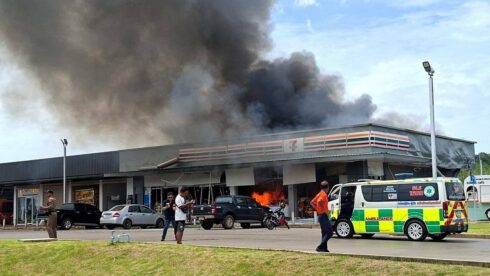Fighting has spread to 12 locations along the disputed Thai-Cambodia border, a Thai military official said on July 25, indicating that the confrontation is escalating.
The clashes broke out a day earlier at the ancient, disputed Ta Muen Thom temple site in the Thai province of Surin, which was claimed by Cambodia. Later, the clashes spread to six locations.
Thai Rear Admiral Surasant Kongsiri, a military spokesperson, also told a news conference that Cambodian forces were continuing to use heavy weapons in their attacks on Thai territory. Video footage confirmed that Cambodia was still firing BM-21 Grad 122 mm rockets. At least one such launcher was, however, destroyed by the Thai military.
From its side, the Cambodian Defense Ministry said that the Thai military, using heavy weapons and cluster munitions, has launched attacks on seven locations inside the country.
Lieutenant General Maly Socheata said that the Thai military also deployed an F-16 fighter jet to bomb Cambodian territory.
Among the areas targeted were the Khloch and Tathav mountain areas and the vicinity of the Ta Muen and Ta Krabei Temples along the disputed border.
“The Cambodian army fought hard and was determined to prevent the Thai invaders from violating Cambodian sovereignty,” Maly Socheata was quoted by the Khmer Times as saying.
The death toll from clashes along the disputed border has risen to at least 14 in Thailand and one in Cambodia, according to authorities.
Multiple videos of the clashes were posted to social networks, including three that show Thai troops firing from a M198 155 mm towed howitzer and a ATMOS 2000 155 mm self-propelled howitzer as well as what is said to be a Thai fixed-wing suicide drone hitting a Cambodian military post.
The clashes broke out following tensions over mine explosions that wounded several Thai troops in the Thai province of Ubon Ratchathani on July 16 and July 23.
Thailand and Cambodia share a 817-kilometer border, largely mapped by the French when they controlled Cambodia as a colony.
Cambodia has previously sought a ruling from the United Nations International Court of Justice over disputed areas, including the site of the ongoing clash. Nevertheless, Thailand does not recognize the court’s jurisdiction and claims that some areas along the border were never fully demarcated, including the sites of the ancient temples.
Chinese Foreign Minister Wang Yi said on July 25 that Beijing stands ready to play a constructive role in helping de-escalate the situation between Thailand and Cambodia.
“The root cause of this issue lies in the lingering consequences left by Western colonialists in the past, and it now needs to be faced calmly and handled properly,” he said in a meeting with Association of Southeast Asian Nations Secretary-General Kao Kim Hourn in Beijing, according to a statement issued by the Chinese Foreign Ministry.
Neither side has picked up yet on the Chinese offer. Military speaking, Thailand has the upper hand, especially when it comes to air power. Still, Cambodia is not short on troops.
_______________________________________________________________________________________________________________________
SouthFront: Analysis and Intelligence
NOW hosted at southfront.press
Previously, SouthFront: Analysis and Intelligence was at southfront.org.
The .org domain name had been blocked by the US (NATO) (https://southfront.press/southfront-org-blocked-by-u-s-controlled-global-internet-supervisor/) globally, outlawed and without any explanation
Back before that, from 2013 to 2015, SouthFront: Analysis and Intelligence was at southfront.com







“moderate terrorists.” deconstructing the nato narrative on syria. “leftists” keep the myth alive
by eva bartlett
global research, july 23, 2025
dissident voice 10 october 2015
region: middle east & north africa, usa
theme: us nato war agenda
in-depth report: syria
what are you trying to achieve by posting so many comments?
he’s a troll, and it is what they do.
between super turbo bot spammer and gideon and his team of village idiots, most comments on sf threds are just rubbish noise. meh.
this article was first published by gr in october 2015.]
over the past five years, the increasingly ridiculous propaganda against president al-assad and the syrian arab army (saa) has ranged from the scripted (otpor fomented -“revolution“) “peaceful protesters under fire” rhetoric, to other deceitful lexicon like “civil war,” and “moderate rebels.”
as the intervention campaigns continue with new terrorist and “humanitarian” actors (literally) constantly
emerging in the nato-alliance’s theatre of death squads, it is worth reviewing some of the important points regarding the war on syria. million person marches
on march 29, 2011 (less than two weeks into the fantasy “revolution”) over 6 million people across syria took to the streets in support of president al-assad. in june, a reported hundreds of thousands marched in damascus in support of the president, with a 2.3 km long syrian flag. in november,
2011 (9 months into the chaos), masses again held demonstrations supporting president al-assad, notably in homs (the so-called “capital of the ‘revolution’”), dara’a (the so-called “birthplace of the ‘revolution’”), deir ez-zour, raqqa, latakia, and damascus.
mass demonstrations like this have occurred repeatedly since, including in march 2012, in may 2014 in the lead-up to presidential elections, and in june 2015, to note just some of the larger rallies.
in may 2013, it was reported that even nato recognized the syrian president’s increased popularity. “the data, relayed to nato over the last month, asserted that 70 percent of syrians support” the assad government. at present, the number is now at least 80 percent.
the most telling barometer of assad’s support base was the presidential elections in june 2014, which saw 74 percent (11.6 million) of 15.8 million registered syrian voters vote, with president al-assad
winning 88 percent of the votes the lengths syrians outside of syria went to in order to vote included flooding the syrian embassy in beirut for two full days (and walking several kilometres to get there) and flying from countries with closed syrian embassies to damascus airport simply to cast their votes. within syria,syrians braved terrorist mortars and rockets designed to keep them from voting; 151 shells were fired on damascus alone, killing 5 and maiming 33 syrians.
for a more detailed look at his broad base of popular support, see professor tim anderson’s “why syrians support bashar al assad.”
the reforms
prior to the events of march 2011 syrians did have legitimate desires for specific reforms, many of which were implemented from the beginning of the unrest. in fact, president al-assad made reforms prior to and following march 17, 2011.
stephen gowans noted some of those early reforms, including:
canceling the emergency law;
amending the the constitution and putting it to a referendum [8.4 million syrians voted; 7.5 million voted in favour of the constitution];
scheduling, then holding, multi-party parliamentary and presidential elections
the constitution, according to gowans, “mandated that the government maintain a role in guiding the economy on behalf of syrian interests, and that the syrian government would
not make syrians work for the interests of western banks, oil companies, and other corporations.”
it also included: “security against sickness, disability and old age; access to health care; free education at all levels”
a provision “requiring that at minimum half the members of the people’s assembly are to be drawn from the ranks of peasants and workers.”
political commentator jay tharappel further articulated:
the new constitution introduced a multi-party political
no surprise that nato’s exile-syrian pawns refused the reforms and a constitution which ensures a sovereign syria secure from the claws of multi-national corporations and western banks.
in his article, “decriminalising bashar – towards a more effective anti-war movement,” writer carlos martinez outlined syria’s positives, including its anti-imperialist, socialist policies; its secularism and multiculturalism; andpoignantlyits continued support for palestinians and anti-zionist stance.
these are all points that contradict the lies spewed over the past nearly five years, and shatter the feeble justification for continuing to wage war on syria.
twisting the numbers to serve the war agenda
the number and nature of syrians killed varies depending on which list one consults. many talking heads draw from one sole source, uk-based syrianrami abdulrahman of the so-called syrian observatory for
human rights(sohr) (run out of his home and based on information provided largely by unnamed “activists”). abdulrahman hasn’t been to syria for 15 years, and, as tony cartalucci noted, is “a member of the so-called ‘syrian opposition’ and seeks the ouster of syrian president bashar al assad.” further, cartalucci explained, “abdul rahman’s operation is indeed funded by the european union and a “european country” he refuses to identify.” so not an impartial source.
in her february 2012 “questioning the syrian casualty list“, political analyst sharmine narwani laid out the logistical difficulties of collating the number of deaths, including:
different casualty lists and difficulty confirming accuracy of any of them.
lack of information on: how deaths were verified and by whom and from what motivation.
lack of information on the dead: civilian, pro or anti government civilians; armed groups; syrian security forces?”
she found that one early casualty list included 29 palestinian refugees “killed by israeli fire on the golan heights on 15 may 2011 and 5 june 2011 when protesters congregated on syria’s armistice line with israel.”
jay tharappel looked at two of the other prime groups cited regarding casualties in syria: the syrian network for human rights (snhr) and the violations documentation center (vdc).
he noted that neither of the groups “are ‘independent’ in the sense that they function merely to provide facts, they’re all open about their agenda to overthrow the syrian government…and for the imposition of a no-fly zone on behalf of the ‘moderate rebels’, whoever they are.”
further, according to tharappel, “the snhr doesn’t provide any evidence to substantiate its assertions about the numbers killed by government forces.
they claim to have ‘documented [victims] by full name, place, and date of death,’ however none of these can be found on their website.” regarding the vdc, he wrote, “there are good reasons to believe the vdc is listing dead insurgents as civilians, as well as mislabeling dead government soldiers as fsa fighters one example he cited was the listing of a jaysh al-islam militant, ‘hisham al-sheikh bakri’, killed by the saa in douma (infested with jaysh al-islam terrorists), in
february 2015, which al-masdar news reported. the vdc alsolisted ‘hisham abd al-aziz al-shaikh bakri’, “however this one is listed as an adult male civilian and not a jaish al-islam fighter,” tharappel wrote.
even embedded war reporter nir rosen, tharappel recalled, in 2012 wrote:
every day the opposition gives a death toll, usually without any explanation of the cause of the deaths. many of those reported killed are in fact
dead opposition fighters, but the cause of their death is hidden and they are described in reports as innocent civilians killed by security forces, as if they were all merely protesting or sitting in their homes.
it would be an understatement to say there are considerable, and intentional, inaccuracies in the lists of these groups. in fact, most of the aforementioned groups fail to note what commentators like paul larudee did:
thus far in the syrian war. but almost half are syrian army soldiers or allied local militia fighters, and two thirds are combatants if we count opposition fighters. either way, the ratio of civilian to military casualties is roughly 1:2, given that the opposition is also inflicting civilian casualties. compare that to the roughly 3:1 ratio in the us war in iraq and 4:1 in the israeli attack on gaza in 2008-9. (the rate of palestinian to israeli casualties was an astronomical 100:1.)
“leftists” keeping the myths alive
public figures like owen jones, and pro-palestinian sites like the middle east eye and the electronic intifada, have a following for their more palatable (and safe) solidarity stance on palestine, but routinely spew rhetoric against syria, which is then echoed by their well-intentioned, if very misinformed, followers.
much of grassroots “leftists”’ anti-syria propaganda is as poisonous as corporate media. routinely, at ostensibly anti-war/anti-imperialist gatherings, the anti-syria narrative is predominant.
for example, at the march 2015 world social forum in tunis, some syria-specific panels spun the fairy tale of “revolutionaries” in syria, one panel alleging: “the protests in syria were peaceful for almost six or seven months;
unarmed people were killed; only then did ‘rebels’ eventually take up arms.”
yet, it is known that from the beginning, in dara’a and throughout syria, armed protesters were firing upon, and butchering, security forces and civilians. tim anderson’s “syria: how the violence began, in daraa” pointed out that police were killed by snipers in the march 17/18 protests; the syrian army was only brought to dara’a following the murder of the policemen.
additionally, a storage of protesters’ weapons was found in dara’a’s al-omari mosque. prem shankar jha’s, “who fired the first shot?” described the slaughter of 20 syrian soldiers outside dara’a a month later, “by cutting their throats, and cutting off the head of one of the soldiers.” a very “moderate”-rebel practice. in “syria: the hidden massacre” sharmine narwani investigated the early massacres of syrian soldiers, noting that many of the murders o
ccurred even after the syrian government had abolished the state security courts, lifted the state of emergency, granted general amnesties, and recognized the right to peaceful protest.
the april 10, 2011 murder of banyas farmer nidal janoud was one of the first horrific murders of syrian civilians by so-called “unarmed protesters.” face gashed open, mutilated and bleeding, janoud was paraded by an armed mob, who then hacked him to death
father frans van der ludt—the dutch priest living in syria for nearly 5 decades prior to his april 7, 2014 assassination by militants occupying the old city of homs—wrote (repeatedly) of the “armed demonstrators” he saw in early protests, “who began to shoot at the police first.”
may 2011 video footage of later-resigned al jazeera journalist ali hashem shows fighters entering syria from lebanon, carrying guns and rpgs (hashem stated he’d likewise seen fighters entering in april).